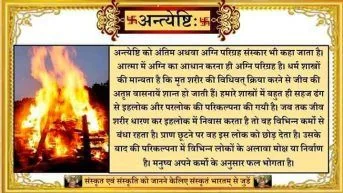Vedic 16 Sanskars – Sacred Ceremonies for a Meaningful Life
In the rich Vedic tradition, there are sixteen essential rites of passage, known as the Vedic 16 Sanskars or Shodasha Sanskars. These sacred ceremonies are performed to support an individual’s physical, mental, social, and spiritual development at various stages of life.
Each Sanskar holds deep spiritual and cultural importance—from Garbhadhan (conception) to Antyeshti (last rites)—guiding one toward a disciplined, value-driven, and spiritually aligned life.
At Astro Shivang, we provide access to learned and experienced Panditjis who perform these rituals with complete devotion and adherence to Vedic traditions.
1: GARBHADHAN SANSKAR
This Sanskara Is Performed For The Fulfillment Of One's Parental Obligation And A Continuation Of The Human Race. This Is A Fervent Prayer For The Impregnation Of The Foetus With The Life-Giving Soul Force. Garbha Means Womb And Dhana Means Give Or Donate. This Sanskara Is Performed After Marriage And Before The Conception Of A Child. In This Sanskara, The Couple Chants Vedic Mantras For A Healthy, Loving And Happy Married Life And The Wish For A Son Or Daughter That Would Bring New Joy In The Home.

2: PUNSAVAN SANSKAR
This Sanskara Is Performed During The Third Or Fourth Month Of Pregnancy To Ensure The Healthy Development Of The Fetus. It Is A Sacred Ritual That Invokes Divine Blessings For The Protection And Well-Being Of The Unborn Child. 'Punsavan' Means 'To Beget A Virtuous Child'. This Sanskara Is Meant To Nourish The Embryo Spiritually And Physically, And To Strengthen The Bond Between Mother And Child. Vedic Mantras Are Chanted For The Growth, Intelligence, And Strength Of The Baby, And For A Safe Journey Through Pregnancy.
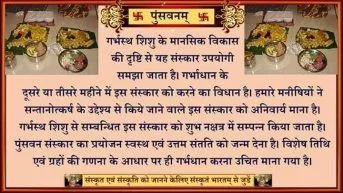
3: SIMANTONNAYAN SANSKAR
This Sanskara Is Performed In The Seventh Month Of Pregnancy To Bless The Expectant Mother And Promote The Mental Development Of The Unborn Child. 'Simantonnayan' Means 'Parting The Hair' And Symbolizes Removing Any Obstacles In The Path Of Mother And Child. It Is A Ritual Of Emotional Support And Celebration, Where Family Members Offer Prayers For The Peace Of Mind, Strength, And Well-Being Of The Mother. Vedic Mantras Are Recited To Invoke Divine Energy For The Baby’s Intellectual And Emotional Growth.
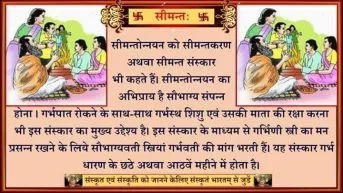
4: JATAKARM SANSKAR
This Sanskara Is Performed Immediately After The Birth Of The Child To Welcome The New Life Into The World With Blessings And Positive Energy. ‘Jatakarma’ Means ‘Birth Ritual’, And It Signifies The Beginning Of The Child’s Journey In Life. The Father Gently Writes ‘AUM’ On The Tongue Of The Newborn With A Gold Stick Dipped In Honey, Symbolizing Purity And Wisdom. He Then Softly Whispers “VEDO-ASI” (You Are Knowledge – The Veda) In The Baby’s Ear, Praying For A Life Filled With Learning, Dharma, And Enlightenment.
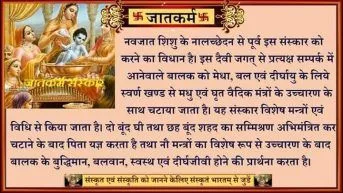
5: NAMAKARAN SANSKAR
This Sanskara Is Performed On The 11th Day After The Birth Of The Child And Marks The Formal Naming Ceremony. ‘Namakaran’ Means ‘To Give A Name’, And It Is A Joyous Occasion Where The Child Is Officially Welcomed Into The Family And Society. A Meaningful Name Is Chosen, Often Based On The Child’s Birth Nakshatra Or Astrological Chart. Vedic Mantras Are Chanted To Bless The Name With Strength, Prosperity, And Good Fortune, As The Name Is Believed To Influence The Child’s Personality And Destiny.

6: NISHKRAMAN SANSKAR
This Sanskara Is Performed In The Fourth Month After The Birth Of The Child And Marks The First Time The Infant Is Taken Outside The Home. ‘Nishkraman’ Means ‘To Step Out’, Symbolizing The Child’s Introduction To The World Beyond The Home. The Baby Is Gently Exposed To Natural Elements Like Sunlight, Fresh Air, And Open Surroundings. Vedic Mantras Are Chanted To Seek Protection From Negative Energies And To Bless The Child With Health, Strength, And A Harmonious Relationship With Nature.
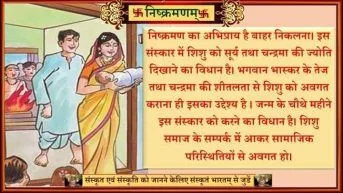
7: ANNA-PRAASHAN SANSKAR
This Sanskara Is Performed When The Child Is Introduced To Solid Food For The First Time, Usually Between The Sixth And Eighth Month. ‘Anna’ Means ‘Food’ And ‘Prashan’ Means ‘Feeding’, Symbolizing The Beginning Of The Child’s Physical Nourishment From The Outside World. This Ceremony Is Celebrated With Joy And Blessings, As The Family Offers Prayers For The Child’s Health, Strength, And Proper Digestion. Vedic Mantras Are Chanted To Invoke Divine Grace For A Life Filled With Vitality And Sustenance.
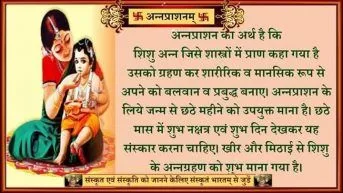
8: MUNDAN SANSKAR
This Sanskara Is Usually Performed Between The Ages Of One To Three Years And Involves Shaving Off The Child’s Hair For The First Time. ‘Mundan’ Symbolizes Purification And The Removal Of Unwanted Traits From Past Lives. The Ritual Is Believed To Promote Healthy Growth Of Hair And Strengthen The Child’s Mind And Body. During The Ceremony, Vedic Mantras Are Chanted To Bless The Child With Long Life, Intelligence, And Protection From Evil Influences. It Is A Moment Of Celebration, Cleansing, And New Beginnings.

9: KARNAVEDH SANSKAR
This Sanskara Is Performed Around The Age Of Three And Involves Piercing The Lower Lobes Of The Child’s Ears. ‘Karnavedh’ Means ‘Ear Piercing’ And Is Considered A Sacred Ritual That Enhances Spiritual Reception And Health. It Is Believed To Activate Certain Nerve Points That Contribute To Intellectual And Physical Development. Vedic Mantras Are Chanted To Seek Divine Blessings For The Child’s Well-Being, Protection From Illness, And A Life Filled With Vitality And Clarity.
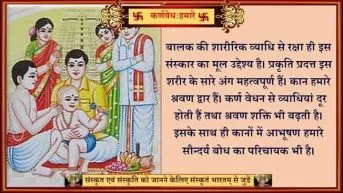
10: UPANAYAN SANSKAR
This Sanskara, Also Known As The Thread Ceremony, Is Performed Between The Ages Of Five To Eight Years And Marks The Beginning Of The Child’s Formal Education And Spiritual Journey. ‘Upanayan’ Means ‘Leading Towards Knowledge’. During This Ritual, The Child Is Given The Yajnopavit (Sacred Thread) Made Of Three Strands Representing The Three Letters Of AUM And The Three Disciplines Of Life – Knowledge, Action, And Devotion. Vedic Mantras Are Recited To Bless The Child With Wisdom, Discipline, And A Life Guided By Dharma.
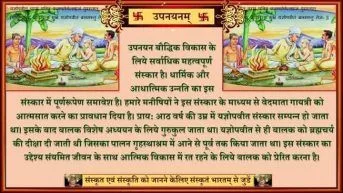
11: VEDARAMBH SANSKAR
This Sanskara Is Performed Immediately After The Upanayan Sanskara And Marks The Child’s Official Entrance Into The Realm Of Formal Education. ‘Vedarambh’ Means ‘Beginning Of The Vedas’, Signifying The Start Of The Child’s Learning Journey. At This Point, The Child Begins To Study The Vedas, Religious Texts, And Other Knowledge Systems, Including Mathematics And Science. The Ceremony Is A Blessing For The Child’s Spiritual And Material Growth, Enabling Them To Progress In Life With Wisdom, Discipline, And Knowledge Across All Realms.
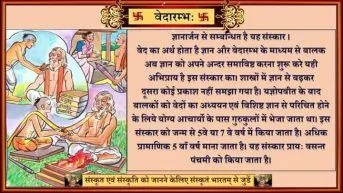
12: SAMAVARTAN SANSKAR
This Sanskara Is Performed Between The Ages Of Twenty-One And Twenty-Five Years, Marking The Completion Of Formal Education And The Transition To A New Phase In Life. ‘Samavartan’ Means ‘Return’ Or ‘Completion’, Signifying The End Of The Student’s Learning Journey. At This Stage, The Individual Has Acquired Knowledge And Wisdom, Ready To Embark On A Life Of Self-Realization, Independence, And Contributing To Society. The Ceremony Celebrates The Transition From Student Life To The Responsibilities Of Adulthood, With Blessings For Success, Fulfillment, And Spiritual Growth.
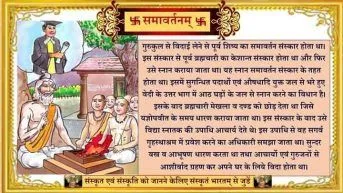
13: VIVAH SANSKAR
Vivah Sanskara Is Performed When The Individual Decides To Enter Into Marriage, Marking One Of The Most Significant Milestones In Life. As One Of The Sixteen Vedic Sacraments, This Sanskara Holds Great Importance In The Formation Of A Stable And Harmonious Family Life. The Marriage Ceremony Represents The Union Of Two Souls, The Beginning Of A Shared Journey, And The Establishment Of A Family Foundation. Through Sacred Vedic Rituals, The Couple Seeks Blessings For A Life Of Love, Unity, Mutual Respect, And Prosperity, As They Embark On The Path Of Togetherness.
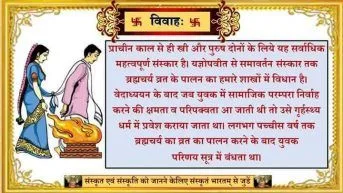
14: VAANAPRASTH SANSKAR
At The Age Of Fifty-One Years, A Person Performs The Vaanaprasth Sanskara, Signifying The Transition From Active Family Life To A Phase Of Detachment And Reflection. ‘Vaanaprasth’ Means ‘Retirement To The Forest’, Symbolizing The Withdrawal From Material Pursuits And The Renunciation Of Personal Benefits. During This Ritual, The Individual Relinquishes Their Livelihood And Responsibilities, Passing On Family Duties To Their Children. This Sanskara Marks The Beginning Of A Life Focused On Spiritual Growth, Meditation, And Self-Realization, Seeking Peace And Inner Contentment In The Later Years.

15: SANNYAAS
At The Age Of Seventy-Five, A Person Performs The Sannyas Sanskara, Marking The Final Stage Of The Spiritual Journey. ‘Sannyas’ Means ‘Renunciation’, And In This Ritual, The Individual Forsakes All Material Attachments, Choosing To Live A Life Of Meditation, Contemplation, And Devotion To The Almighty. It Represents A Complete Detachment From Worldly Desires And A Deep Commitment To The Pursuit Of Spiritual Knowledge And Self-Realization. The Sannyasi Focuses Entirely On Attaining Moksha (Liberation) Through Prayer, Contemplation, And Divine Connection.

16: ANTYESHTI SANSKAR
The Antyeshti Sanskara Is The Final Rite Performed After The Death Of An Individual. It Marks The Completion Of The Life Cycle And The Return Of The Physical Body To The Elements. This Ritual Involves The Cremation Of The Body, Symbolizing The Return Of The Mortal Form To Earth, Water, Fire, Air, And Ether. While The Body Perishes, The Atma (Soul) Is Believed To Be Immortal And Continues Its Journey Beyond. Through This Ceremony, Prayers Are Offered For The Peaceful Journey Of The Soul, Seeking Liberation (Moksha) From The Cycle Of Rebirth.
